

American Civil War
A few Photos from the excellent Civil War artifact collection at the Atlanta Historic Center
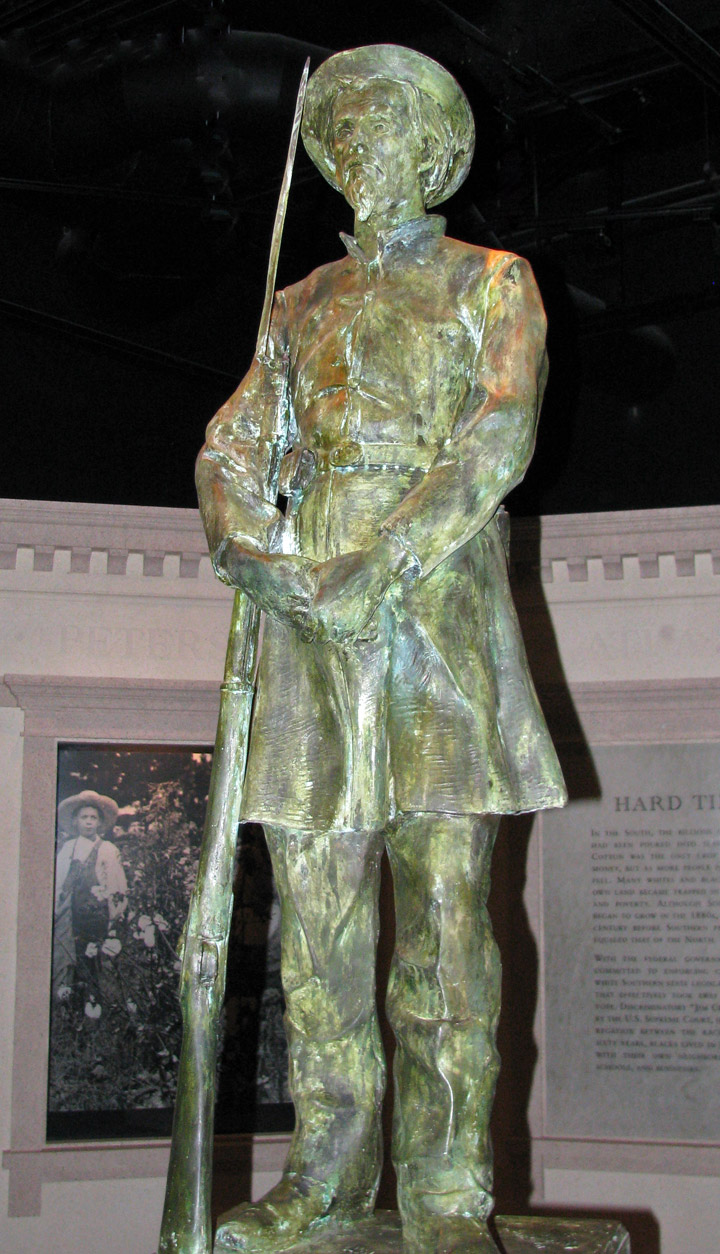
Confederate Hero
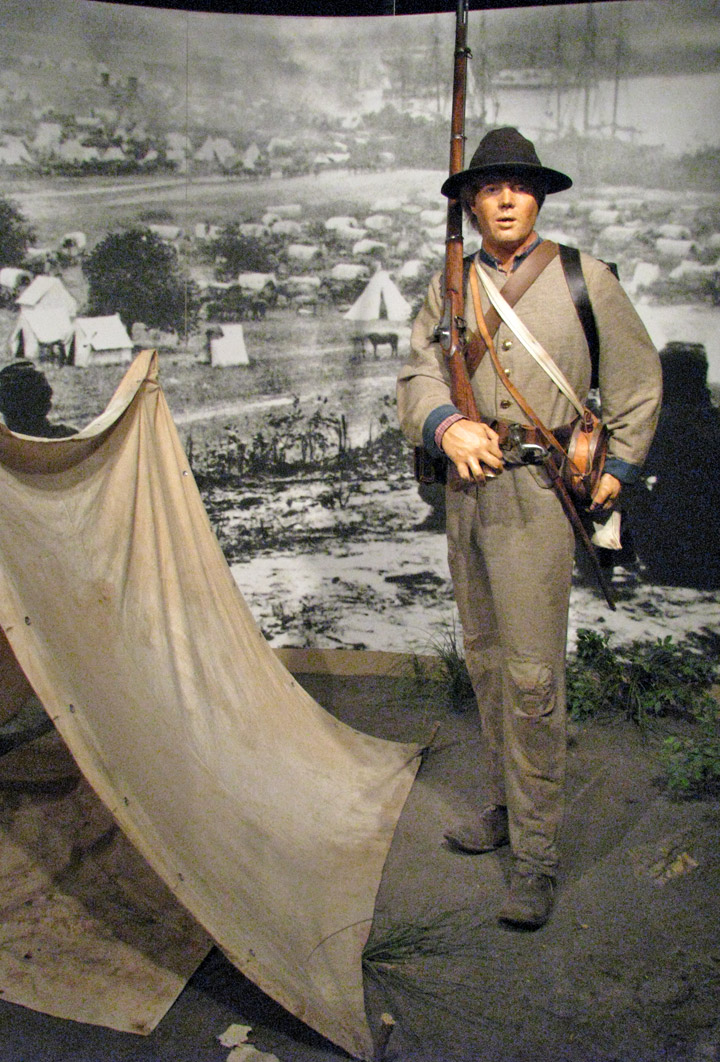
Confederate soldier
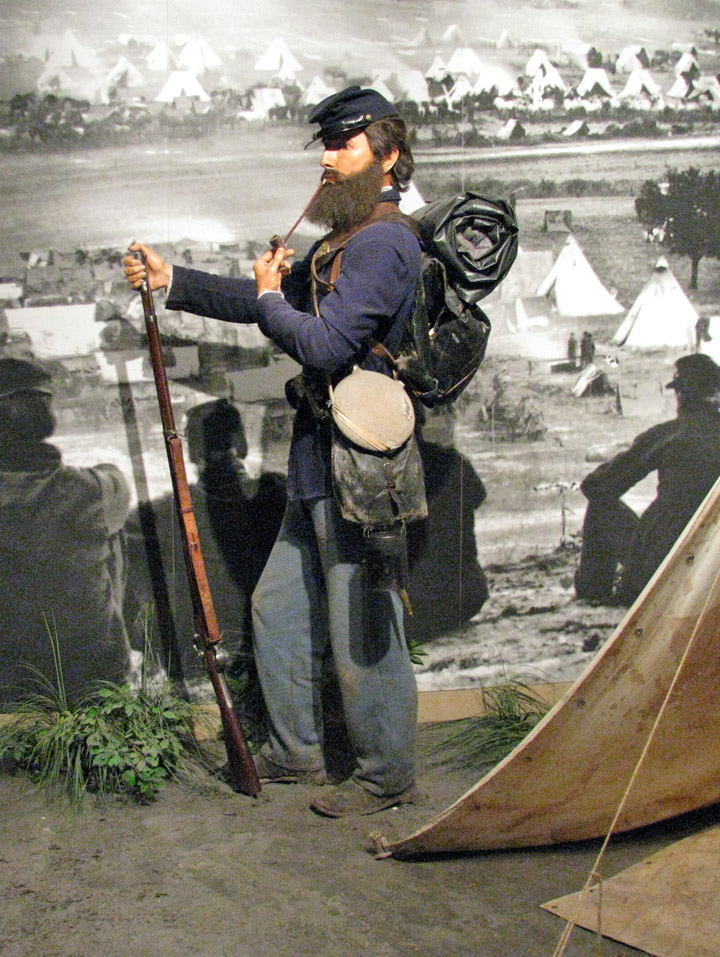
Union soldier

woman assembling bullet cartridges
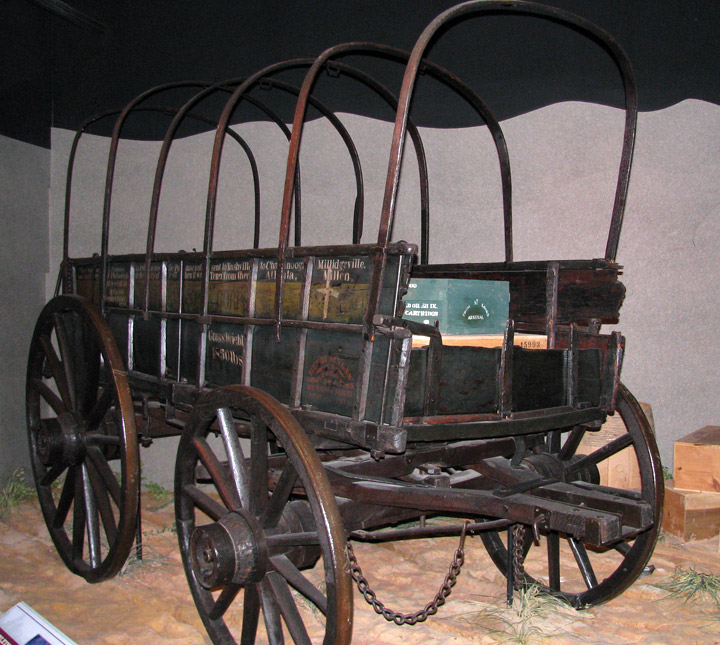
an ammunition wagon
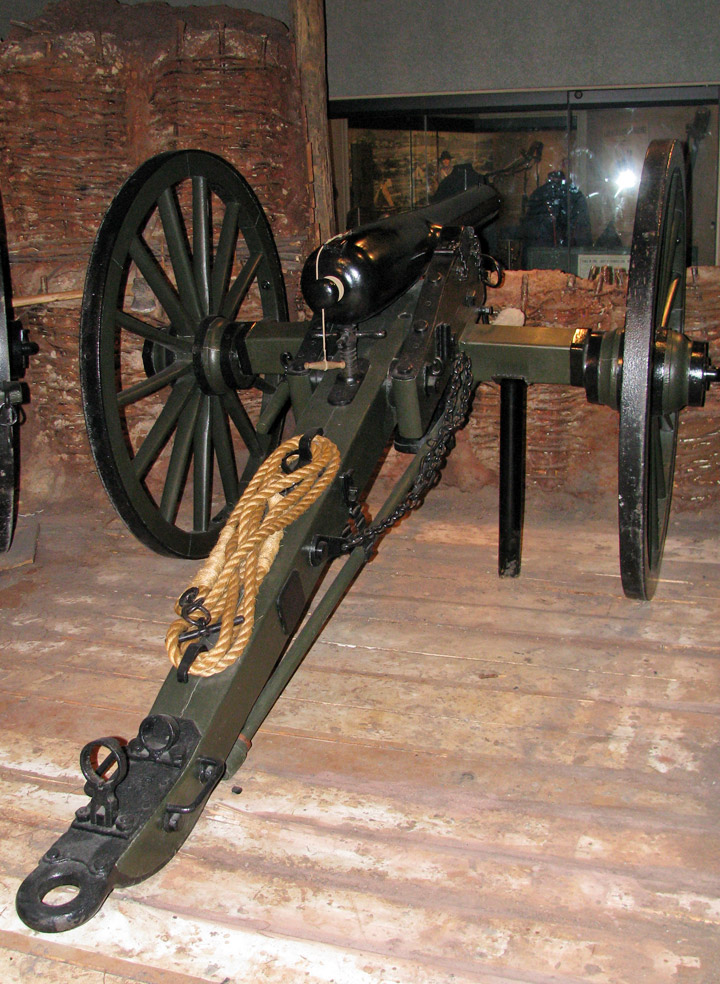
artillery piece
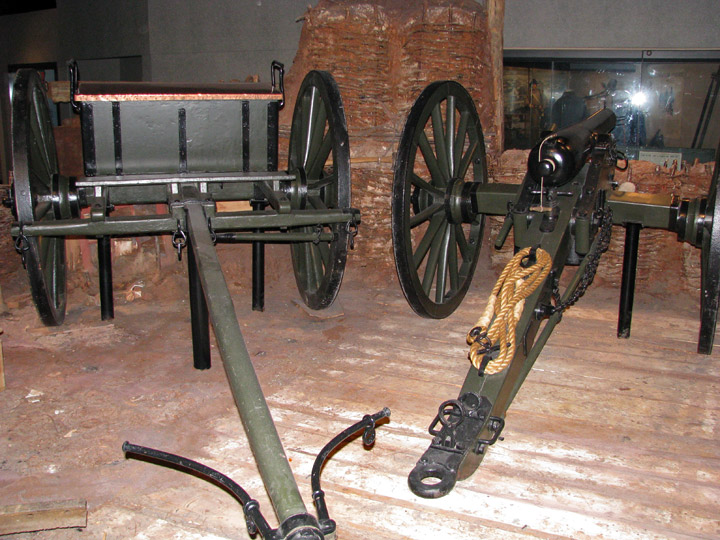
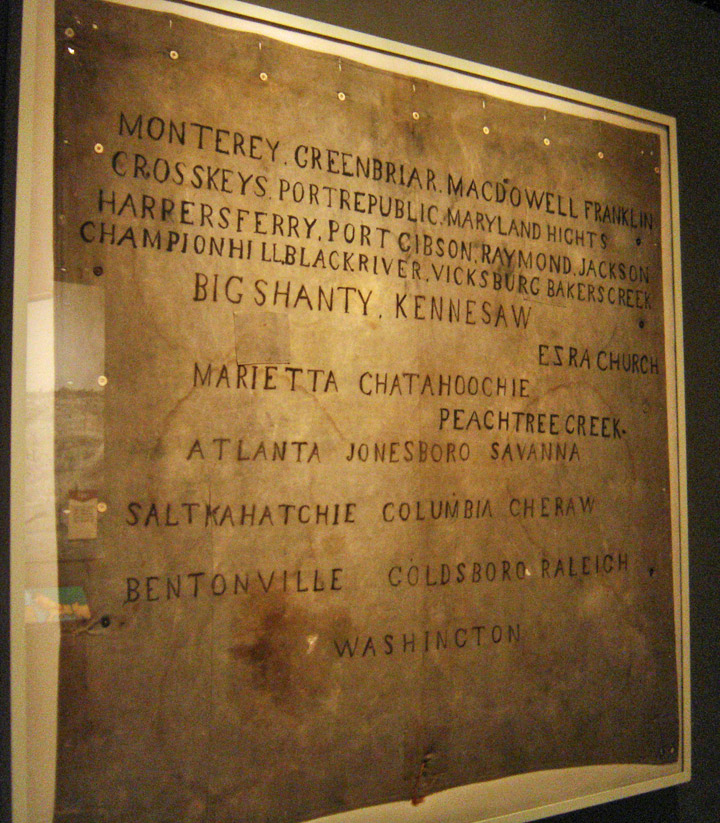
a soldier's list of campaigns

the scene in Atlanta in 1865
ammunition train blown up at the Atlanta railroad yards
Description of the Civil War from Wikipedia
The American Civil War (1861–1865), also known as the War Between
the States and several other names, was a civil war in the United States of
America. Eleven Southern slave states declared their secession from the U.S. and
formed the Confederate States of America (the Confederacy). Led by Jefferson
Davis, they fought against the U.S. federal government (the "Union"), which was
supported by all the free states and the five border slave states.
In the presidential election of 1860, the Republican Party, led by Abraham
Lincoln, had campaigned against the expansion of slavery beyond the states in
which it already existed. The Republican victory in that election resulted in
seven Southern states declaring their secession from the Union even before
Lincoln took office on March 4, 1861. Both the outgoing and incoming U.S.
administrations rejected secession, regarding it as rebellion.
Hostilities began on April 12, 1861, when Confederate forces attacked a U.S.
military installation at Fort Sumter in South Carolina. Lincoln responded by
calling for a volunteer army from each state, leading to declarations of
secession by four more Southern slave states. Both sides raised armies as the
Union assumed control of the border states early in the war and established a
naval blockade. In September 1862, Lincoln's Emancipation Proclamation made
ending slavery in the South a war goal, and dissuaded the British from
intervening. Confederate commander Robert E. Lee won battles in the east, but in
1863 his northward advance was turned back at Gettysburg and, in the west, the
Union gained control of the Mississippi River at the Battle of Vicksburg,
thereby splitting the Confederacy. Long-term Union advantages in men and
material were realized in 1864 when Ulysses S. Grant fought battles of attrition
against Lee as Union general William Sherman captured Atlanta, Georgia, and
marched to the sea. Confederate resistance collapsed after Lee surrendered to
Grant at Appomattox Court House on April 9, 1865.
The war, the deadliest in American history, caused 620,000 soldier deaths and an
undetermined number of civilian casualties, ended slavery in the United States,
restored the Union, and strengthened the role of the federal government. The
social, political, economic and racial issues of the war decisively shaped the
reconstruction era that lasted to 1877, and continued into the 20th century.
The coexistence of a slave-owning South with an increasingly anti-slavery North
made conflict likely. Lincoln did not propose federal laws against slavery where
it already existed, but he had, in his 1858 House Divided Speech, expressed a
desire to "arrest the further spread of it, and place it where the public mind
shall rest in the belief that it is in the course of ultimate extinction".
Much of the political battle in the 1850s focused on the expansion of slavery
into the newly created territories. All of the organized territories were likely
to become free-soil states, which increased the Southern movement toward
secession. Both North and South assumed that if slavery could not expand it
would wither and die.
Southern fears of losing control of the federal government to antislavery
forces, and Northern fears that the slave power already controlled the
government, brought the crisis to a head in the late 1850s. Sectional
disagreements over the morality of slavery, the scope of democracy and the
economic merits of free labor vs. slave plantations caused the Whig and
"Know-Nothing" parties to collapse, and new ones to arise (the Free Soil Party
in 1848, the Republicans in 1854, the Constitutional Union in 1860). In 1860,
the last remaining national political party, the Democratic Party, split along
sectional lines.
Both North and South were influenced by the ideas of Thomas Jefferson.
Southerners emphasized, in connection with slavery, the states' rights
ideas mentioned in Jefferson's Kentucky Resolutions. Northerners ranging from
the abolitionist William Lloyd Garrison to the moderate Republican leader
Abraham Lincoln emphasized Jefferson's declaration that all men are created
equal. Lincoln mentioned this proposition in his Gettysburg Address.
Confederate Vice President Alexander Stephens said that slavery was "the
cornerstone of the Confederacy" after Southern states seceded. After Southern
defeat, Stephens said that the war was not about slavery but states' rights, and
became one of the most ardent defenders of the Lost Cause. Confederate
President Jefferson Davis also switched from saying the war was caused by
slavery to saying that states' rights was the cause. While Southerners often
used states rights arguments to defend slavery, sometimes roles were reversed,
as when Southerners demanded national laws to defend their interests with the
Gag Rule and the Fugitive Slave Law of 1850. On these issues, it was Northerners
who wanted to defend the rights of their states.
Almost all of the inter-regional crises involved slavery, starting with debates
on the three-fifths clause and a twenty year extension of the African Slave
Trade in the Constitutional Convention of 1787. There was controversy over
adding the slave state of Missouri to the Union that led to the Missouri
Compromise of 1820, the Nullification Crisis over the Tariff of 1828 (although
the tariff was low after 1846, and even the tariff issue was related to
slavery), the Gag rule that prevented discussion in Congress of petitions
for ending slavery from 1835–1844, the acquisition of Texas as a slave state in
1845 and Manifest Destiny as an argument for gaining new territories where
slavery would become an issue after the Mexican-American War (1846–1848), which
resulted in the Compromise of 1850. The Wilmot Proviso was an attempt by
Northern politicians to exclude slavery from the territories conquered from
Mexico. The extremely popular antislavery novel Uncle Tom’s Cabin (1852) by
Harriet Beecher Stowe greatly increased Northern opposition to the Fugitive
Slave Law of 1850.
The 1854 Ostend Manifesto was an unsuccessful Southern attempt to annex Cuba as
a slave state. Rival plans for Northern vs. Southern routes for a
transcontinental railroad became entangled in the Bleeding Kansas controversy
over slavery. The Second Party System broke down after passage of the
Kansas-Nebraska Act in 1854, which replaced the Missouri Compromise ban on
slavery with popular sovereignty, allowing the people of a territory to vote for
or against slavery. In 1856 Congressional arguments over slavery became violent
when Representative Preston Brooks of South Carolina attacked and severely
wounded Republican Senator Charles Sumner on the Senate floor after Sumner's
"Crime against Kansas" speech. The 1857 Supreme Court Dred Scott decision
allowed slavery in the territories even where the majority opposed slavery,
including Kansas. The Lecompton Constitution of 1857 was a controversial attempt
to admit Kansas to the Union as a slave state. The Lincoln-Douglas debates of
1858 included Northern Democratic leader Stephen Douglas' Freeport Doctrine.
This doctrine was an argument for thwarting the Dred Scott decision which, along
with Douglas' defeat of the Lecompton Constitution, divided the Democratic Party
between North and South. Northern abolitionist John Brown's raid at Harpers
Ferry Armory was an attempt to incite slave insurrections in 1859. The
North-South split in the Democratic Party in 1860 due to the Southern demand for
a slave code for the territories completed polarization of the nation between
North and South.
Other factors include sectionalism (caused by the growth of slavery in the lower
South while slavery was gradually phased out in Northern states) and economic
differences between North and South, although most modern historians disagree
with the extreme economic determinism of historian Charles Beard and argue that
Northern and Southern economies were largely complementary. There was the
polarizing effect of slavery that split the largest religious denominations (the
Methodist, Baptist and Presbyterian churches) and controversy caused by the
worst cruelties of slavery (whippings, mutilations and families split apart).
The fact that seven immigrants out of eight settled in the North, plus the fact
that twice as many whites left the South for the North as vice versa,
contributed to the South's defensive-aggressive political behavior.
The election of Lincoln in 1860 was the final trigger for secession. Efforts
at compromise, including the "Corwin Amendment" and the "Crittenden Compromise",
failed. Southern leaders feared that Lincoln would stop the expansion of slavery
and put it on a course toward extinction. The slave states, which had already
become a minority in the House of Representatives, were now facing a future as a
perpetual minority in the Senate and Electoral College against an increasingly
powerful North.
A strong correlation was shown between the degree of support for secession and
the number of plantations in the region; states of the deep South which had the
greatest concentration of plantations were the first to secede. The upper South
slave states of Virginia, North Carolina, Arkansas, and Tennessee had fewer
plantations and rejected secession until the Fort Sumter crisis forced them to
choose sides. Border states had fewer plantations still and never
seceded. The percentage of Southern whites living in families that owned
slaves was 36.7 percent in the lower South, 25.3 percent in the upper South and
15.9 percent in the border states that fought mostly for the Union.
Ninety-five percent of blacks lived in the South, comprising one third of the
population there as opposed to one percent of the population of the North.
Consequently, fears of eventual emancipation were much greater in the South than
in the North.
The Supreme Court decision of 1857 in Dred Scott v. Sandford added to the
controversy. Chief Justice Roger B. Taney's decision said that slaves were "so
far inferior that they had no rights which the white man was bound to
respect", and that slavery could spread into the territories. Lincoln warned
that "the next Dred Scott decision" could threaten Northern states with
slavery.
Northern politician Abraham Lincoln said, "this question of Slavery was more
important than any other; indeed, so much more important has it become that no
other national question can even get a hearing just at present." The slavery
issue was related to sectional competition for control of the territories,
and the Southern demand for a slave code for the territories was the issue used
by Southern politicians to split the Democratic Party in two, which all but
guaranteed the election of Lincoln and secession. When secession was an issue,
South Carolina planter and state Senator John Townsend said that "our enemies
are about to take possession of the Government, that they intend to rule us
according to the caprices of their fanatical theories, and according to the
declared purposes of abolishing slavery." Similar opinions were expressed
throughout the South in editorials, political speeches and declarations of
reasons for secession. Even though Lincoln had no plans to outlaw slavery where
it existed, Southerners throughout the South expressed fears for the future of
slavery.
Southern concerns included not only economic loss but also fears of racial
equality. The Texas Declaration of Causes for Secession
said that the non-slave-holding states were "proclaiming the debasing doctrine
of equality of all men, irrespective of race or color", and that the African
race "were rightfully held and regarded as an inferior and dependent race".
Alabama secessionist E. S. Dargan said that emancipation would make Southerners
feel "demoralized and degraded".
Beginning in the 1830s, the U.S. Postmaster General refused to allow mail which
carried abolition pamphlets to the South. Northern teachers suspected of any
tinge of abolitionism were expelled from the South, and abolitionist literature
was banned. Southerners rejected the denials of Republicans that they were
abolitionists. The North felt threatened as well, for as Eric Foner
concludes, "Northerners came to view slavery as the very antithesis of the good
society, as well as a threat to their own fundamental values and interests".
South Carolina adopted the "Declaration of the Immediate Causes Which Induce and
Justify the Secession of South Carolina from the Federal Union" on December 24,
1860. It argued for states' rights for slave owners in the South, but contained
a complaint about states' rights in the North in the form of opposition to the
Fugitive Slave Act, claiming that Northern states were not fulfilling their
federal obligations under the Constitution. All of the alleged violations of the
rights of Southern states were related to slavery.
Before Lincoln took office, seven states had declared their secession from the
Union. They established a Southern government, the Confederate States of America
on February 9, 1861. They took control of federal forts and other properties
within their boundaries with little resistance from outgoing President James
Buchanan, whose term ended on March 4, 1861. Buchanan asserted, "The South has
no right to secede, but I have no power to prevent them." One quarter of the
U.S. Army—the entire garrison in Texas—was surrendered to state forces by its
commanding general, David E. Twiggs, who then joined the Confederacy.
As Southerners resigned their seats in the Senate and the House, secession later
enabled Republicans to pass bills for projects that had been blocked by Southern
Senators before the war, including the Morrill Tariff, land grant colleges (the
Morill Act), a Homestead Act, a trans-continental railroad (the Pacific Railway
Acts), the National Banking Act and the authorization of United States Notes by
the Legal Tender Act of 1862. The Revenue Act of 1861 introduced the income tax
to help finance the war.
Status of the states, 1861. States that seceded before April 15, 1861 States
that seceded after April 15, 1861 Union states that permitted slavery Union
states that banned slavery Territories
Seven Deep South cotton states seceded by February 1861, starting with South
Carolina, Mississippi, Florida, Alabama, Georgia, Louisiana, and Texas. These
seven states formed the Confederate States of America (February 4, 1861), with
Jefferson Davis as president, and a governmental structure closely modeled on
the U.S. Constitution. Following the attack on Fort Sumter, President Lincoln
called for a volunteer army from each state. Within two months, four more
Southern slave states declared their secession and joined the Confederacy:
Virginia, Arkansas, North Carolina and Tennessee. The northwestern portion of
Virginia subsequently seceded from Virginia, joining the Union as the new state
of West Virginia on June 20, 1863. By the end of 1861, Missouri and Kentucky
were divided -- each of them having a pro-Southern and pro-Northern government.
Twenty-three states remained loyal to the Union: California, Connecticut,
Delaware, Illinois, Indiana, Iowa, Kansas, Kentucky, Maine, Maryland,
Massachusetts, Michigan, Minnesota, Missouri, New Hampshire, New Jersey, New
York, Ohio, Oregon, Pennsylvania, Rhode Island, Vermont, and Wisconsin. During
the war, Nevada and West Virginia joined as new states of the Union. Tennessee
and Louisiana were returned to Union military control early in the war.
The territories of Colorado, Dakota, Nebraska, Nevada, New Mexico, Utah, and
Washington fought on the Union side. Several slave-holding Native American
tribes supported the Confederacy, giving the Indian territory (now Oklahoma) a
small bloody civil war.
The Border states in the Union were West Virginia (which was separated from
Virginia and became a new state), and four of the five northernmost slave states
(Maryland, Delaware, Missouri, and Kentucky).
Maryland had numerous pro-Confederate officials who tolerated anti-Union rioting
in Baltimore and the burning of bridges. Lincoln responded with martial law and
called for troops. Militia units that had been drilling in the North rushed
toward Washington and Baltimore. Before the Confederate government realized
what was happening, Lincoln had seized firm control of Maryland (and the
separate District of Columbia), by arresting all the Maryland government members
and holding them without trial.
In Missouri, an elected convention on secession voted decisively to remain
within the Union. When pro-Confederate Governor Claiborne F. Jackson called out
the state militia, it was attacked by federal forces under General Nathaniel
Lyon. After the Camp Jackson Affair Lyon chased the governor and the rest of the
State Guard to the southwestern corner of the state. In the resulting vacuum, the convention on secession reconvened and
took power as the Unionist provisional government of Missouri.
Kentucky did not secede; for a time, it declared itself neutral. When
Confederate forces entered the state in September, 1861, neutrality ended and
the state reaffirmed its loyal status, while trying to maintain slavery. During
a brief invasion by Confederate forces, Confederate sympathizers organized a
secession convention, inaugurated a governor, and gained recognition from the
Confederacy. The rebel government soon went into exile and never controlled
Kentucky.
After Virginia voted to secede, Union supporters in fifty counties of
northwestern Virginia voted on October 24, 1861 to approve the creation of the
new state of West Virginia. The majority of the voters in what was to become
West Virginia had voted against Virginia’s secession, although twenty six of
the fifty counties had pro-secession majorities. About half of West Virginia's
soldiers were Confederate. This new state was admitted to the Union on June 20,
1863.
Similar Unionist secessions attempts appeared in East Tennessee, but were
suppressed by the Confederacy. Jefferson Davis arrested over 3000 men suspected
of being loyal to the Union and held them without trial.
Over 10,000 military engagements took place during the war, 40% of them in
Virginia and Tennessee.
Lincoln's victory in the presidential election of 1860 triggered South
Carolina's declaration of secession from the Union. By February 1861, six more
Southern states made similar declarations. On February 7, the seven states
adopted a provisional constitution for the Confederate States of America and
established their temporary capital at Montgomery, Alabama. A pre-war February
Peace Conference of 1861 met in Washington in a failed attempt at resolving the
crisis. The remaining eight slave states rejected pleas to join the Confederacy.
Confederate forces seized most of the federal forts within their boundaries.
President Buchanan protested but made no military response aside from a failed
attempt to resupply Fort Sumter via the ship Star of the West, which was fired
upon by Citadel cadets before it reached the fort. However, governors in
Massachusetts, New York, and Pennsylvania quietly began buying weapons and
training militia units.
On March 4, 1861, Abraham Lincoln was sworn in as President. In his inaugural
address, he argued that the Constitution was a more perfect union than the
earlier Articles of Confederation and Perpetual Union, that it was a binding
contract, and called any secession "legally void". He stated he had no
intent to invade Southern states, nor did he intend to end slavery where it
existed, but that he would use force to maintain possession of federal property.
His speech closed with a plea for restoration of the bonds of union.
The South sent delegations to Washington and offered to pay for the federal
properties and enter into a peace treaty with the United States. Lincoln
rejected any negotiations with Confederate agents on the grounds that the
Confederacy was not a legitimate government, and that making any treaty with it
would be tantamount to recognition of it as a sovereign government. However,
Secretary of State William Seward engaged in unauthorized and indirect
negotiations that failed.
Fort Sumter in Charleston, South Carolina, Fort Monroe, Fort Pickens and Fort
Taylor were the remaining Union-held forts in the Confederacy, and Lincoln was
determined to hold Fort Sumter. Under orders from Confederate President
Jefferson Davis, troops controlled by the Confederate government under P. G. T.
Beauregard bombarded the fort with artillery on April 12, forcing the fort's
capitulation. Northerners rallied behind Lincoln's call for all of the states to
send troops to recapture the forts and to preserve the Union. With the scale of
the rebellion apparently small so far, Lincoln called for 75,000 volunteers for
90 days. For months before that, several Northern governors had discreetly
readied their state militias; they began to move forces the next day.
Four states in the upper South (Tennessee, Arkansas, North Carolina, and
Virginia), which had repeatedly rejected Confederate overtures, now refused to
send forces against their neighbors, declared their secession, and joined the
Confederacy. To reward Virginia, the Confederate capital was moved to
Richmond. The city was the symbol of the Confederacy. Richmond was in a
highly vulnerable location at the end of a tortuous Confederate supply line.
Although Richmond was heavily fortified, supplies for the city would be reduced
by Sherman's capture of Atlanta and cut off almost entirely when Grant besieged
Petersburg and its railroads that supplied the Southern capital.
Winfield Scott, the commanding general of the U.S. Army, devised the Anaconda
Plan to win the war with as little bloodshed as possible. His idea was that
a Union blockade of the main ports would weaken the Confederate economy; then
the capture of the Mississippi River would split the South. Lincoln adopted the
plan, but overruled Scott's warnings against an immediate attack on Richmond.
In May 1861, Lincoln enacted the Union blockade of all Southern ports, ending
most international shipments to the Confederacy. Violators' ships and cargos
could be seized and were often not covered by insurance. By late 1861, the
blockade stopped most local port-to-port traffic. The blockade shut down King
Cotton, ruining the Southern economy. British investors built small, fast
"blockade runners" that traded arms and luxuries from Bermuda, Cuba and the
Bahamas in return for high-priced cotton and tobacco. When captured, the
blockade runners and cargo were sold and the proceeds given to the Union
sailors, but the British crews were released. Shortages of food and other goods
triggered by the blockade, foraging by Northern armies, and the impressments of
crops by Confederate armies combined to cause hyperinflation and bread riots in
the South.
On March 8, 1862, the Confederate Navy waged a fight against the Union Navy when
the ironclad CSS Virginia attacked the blockade; it seemed unstoppable but the
next day it had to fight the new Union warship USS Monitor in the Battle of the
Ironclads. The battle ended in a draw, which was a strategic victory for the
Union in that the blockade was sustained. The Confederacy lost the CSS Virginia
when the ship was scuttled to prevent capture, and the Union built many copies
of the USS Monitor. Lacking the technology to build effective warships, the
Confederacy attempted to obtain warships from Britain. The Union victory at the
Second Battle of Fort Fisher in January 1865 closed the last useful Southern
port and virtually ended blockade running.
Because of the fierce resistance of a few initial Confederate forces at
Manassas, Virginia, in July 1861, a march by Union troops under the command of
Maj. Gen. Irvin McDowell on the Confederate forces there was halted in the First
Battle of Bull Run, or First Manassas, whereupon they were forced back to
Washington, D.C., by Confederate troops under the command of Generals Joseph E.
Johnston and P. G. T. Beauregard. It was in this battle that Confederate General
Thomas Jackson received the nickname of "Stonewall" because he stood like a
stone wall against Union troops. Alarmed at the loss, and in an attempt to
prevent more slave states from leaving the Union, the U.S. Congress passed the
Crittenden-Johnson Resolution on July 25 of that year, which stated that the war
was being fought to preserve the Union and not to end slavery.
Maj. Gen. George B. McClellan took command of the Union Army of the Potomac on
July 26 (he was briefly general-in-chief of all the Union armies, but was
subsequently relieved of that post in favor of Maj. Gen. Henry W. Halleck), and
the war began in earnest in 1862. Upon the strong urging of President Lincoln to
begin offensive operations, McClellan attacked Virginia in the spring of 1862 by
way of the peninsula between the York River and James River, southeast of
Richmond. Although McClellan's army reached the gates of Richmond in the
Peninsula Campaign, Johnston halted his advance at the Battle of
Seven Pines, then General Robert E. Lee and top subordinates James Longstreet
and Stonewall Jackson defeated McClellan in the Seven Days Battles and
forced his retreat. The Northern Virginia Campaign, which included the Second
Battle of Bull Run, ended in yet another victory for the South.[69] McClellan
resisted General-in-Chief Halleck's orders to send reinforcements to John Pope's
Union Army of Virginia, which made it easier for Lee's Confederates to defeat
twice the number of combined enemy troops.
Emboldened by Second Bull Run, the Confederacy made its first invasion of the
North, when General Lee led 45,000 men of the Army of Northern Virginia across
the Potomac River into Maryland on September 5. Lincoln then restored Pope's
troops to McClellan. McClellan and Lee fought at the Battle of Antietam near
Sharpsburg, Maryland, on September 17, 1862, the bloodiest single day in United
States military history. Lee's army, checked at last, returned to Virginia
before McClellan could destroy it. Antietam is considered a Union victory
because it halted Lee's invasion of the North and provided an opportunity for
Lincoln to announce his Emancipation Proclamation.
When the cautious McClellan failed to follow up on Antietam, he was replaced by
Maj. Gen. Ambrose Burnside. Burnside was soon defeated at the Battle of
Fredericksburg on December 13, 1862, when over twelve thousand Union
soldiers were killed or wounded during repeated futile frontal assaults against Marye's Heights. After the battle, Burnside was replaced by Maj. Gen. Joseph
Hooker. Hooker, too, proved unable to defeat Lee's army; despite outnumbering
the Confederates by more than two to one, he was humiliated in the Battle of
Chancellorsville in May 1863. He was replaced by Maj. Gen. George Meade
during Lee's second invasion of the North, in June. Meade defeated Lee at the
Battle of Gettysburg (July 1 to July 3, 1863), the bloodiest battle of the
war, which is sometimes considered the war's turning point. Pickett's Charge on
July 3 is often recalled as the high-water mark of the Confederacy, not just
because it signaled the end of Lee's plan to pressure Washington from the north,
but also because Vicksburg, Mississippi, the key stronghold to control of the
Mississippi, fell the following day. Lee's army suffered 28,000 casualties
(versus Meade's 23,000). However, Lincoln was angry that Meade failed to
intercept Lee's retreat, and after Meade's inconclusive Fall campaign, Lincoln
decided to turn to the Western Theater for new leadership.
While the Confederate forces had numerous successes in the Eastern theater, they
were defeated many times in the West. They were driven from Missouri early in
the war as a result of the Battle of Pea Ridge. Leonidas Polk's invasion of
Columbus, Kentucky ended Kentucky's policy of neutrality and turned that state
against the Confederacy.
Nashville, Tennessee, fell to the Union early in 1862. Most of the Mississippi
was opened with the taking of Island No. 10 and New Madrid, Missouri, and then
Memphis, Tennessee. The Union Navy captured New Orléans without a major
fight in May 1862, allowing the Union forces to begin moving up the Mississippi
as well. Only the fortress city of Vicksburg, Mississippi, prevented
unchallenged Union control of the entire river.
General Braxton Bragg's second Confederate invasion of Kentucky ended with a
meaningless victory over Maj. Gen. Don Carlos Buell at the Battle of
Perryville, although Bragg was forced to end his attempt at liberating
Kentucky and retreat due to lack of support for the Confederacy in that state.
Bragg was narrowly defeated by Maj. Gen. William Rosecrans at the Battle of
Stones River in Tennessee.
The one clear Confederate victory in the West was the Battle of Chickamauga.
Bragg, reinforced by Lt. Gen. James Longstreet's corps (from Lee's army in the
east), defeated Rosecrans, despite the heroic defensive stand of Maj. Gen.
George Henry Thomas. Rosecrans retreated to Chattanooga, which Bragg then
besieged.
The Union's key strategist and tactician in the West was Ulysses S. Grant, who
won victories at Forts Henry and Donelson (by which the Union seized control of
the Tennessee and Cumberland Rivers); the Battle of Shiloh; and the Battle
of Vicksburg, which cemented Union control of the Mississippi River and is
considered one of the turning points of the war. Grant marched to the relief of Rosecrans and defeated Bragg at the Third Battle of Chattanooga, driving
Confederate forces out of Tennessee and opening a route to Atlanta and the heart
of the Confederacy.
Guerrilla activity turned much of Missouri into a battleground. Missouri had, in
total, the third-most battles of any state during the war. The other states
of the west, though geographically isolated from the battles to the east, saw
numerous small-scale military actions. Battles in the region served to secure
Missouri, Indian Territory, New Mexico Territory, and Arizona Territory for the
Union. Confederate incursions into Arizona and New Mexico territories were
repulsed in 1862 and a Union campaign to secure Indian Territory succeeded in
1863. Late in the war, the Union's Red River Campaign was a failure. Texas
remained in Confederate hands throughout the war, but was cut off from the rest
of the Confederacy after the capture of Vicksburg in 1863 gave the Union control
of the Mississippi River.
At the beginning of 1864, Lincoln made Grant commander of all Union armies.
Grant made his headquarters with the Army of the Potomac, and put Maj. Gen.
William Tecumseh Sherman in command of most of the western armies. Grant
understood the concept of total war and believed, along with Lincoln and
Sherman, that only the utter defeat of Confederate forces and their economic
base would bring an end to the war. This was total war not in terms of
killing civilians but rather in terms of destroying homes, farms and railroad
tracks. Grant devised a coordinated strategy that would strike at the entire
Confederacy from multiple directions: Generals George Meade and Benjamin Butler
were ordered to move against Lee near Richmond; General Franz Sigel (and later
Philip Sheridan) were to attack the Shenandoah Valley; General Sherman was to
capture Atlanta and march to the sea (the Atlantic Ocean); Generals George Crook
and William W. Averell were to operate against railroad supply lines in West
Virginia; and Maj. Gen. Nathaniel P. Banks was to capture Mobile, Alabama.
Union forces in the East attempted to maneuver past Lee and fought several
battles during that phase ("Grant's Overland Campaign") of the Eastern campaign.
Grant's battles of attrition at the Wilderness, Spotsylvania, and Cold
Harbor resulted in heavy Union losses, but forced Lee's Confederates to fall
back again and again. An attempt to outflank Lee from the south failed under
Butler, who was trapped inside the Bermuda Hundred river bend. Grant was
tenacious and, despite astonishing losses (over 65,000 casualties in seven
weeks), kept pressing Lee's Army of Northern Virginia back to Richmond. He
pinned down the Confederate army in the Siege of Petersburg, where the two
armies engaged in trench warfare for over nine months.
Grant finally found a commander, General Philip Sheridan, aggressive enough to
prevail in the Valley Campaigns of 1864. Sheridan defeated Maj. Gen. Jubal A.
Early in a series of battles, including a final decisive defeat at the Battle of
Cedar Creek. Sheridan then proceeded to destroy the agricultural base of the
Shenandoah Valley, a strategy similar to the tactics Sherman later employed
in Georgia.
Meanwhile, Sherman marched from Chattanooga to Atlanta, defeating Confederate
Generals Joseph E. Johnston and John Bell Hood along the way. The fall of
Atlanta, on September 2, 1864, was a significant factor in the reelection of
Lincoln as president. Hood left the Atlanta area to menace Sherman's supply
lines and invade Tennessee in the Franklin-Nashville Campaign. Union Maj.
Gen. John M. Schofield defeated Hood at the Battle of Franklin, and George H.
Thomas dealt Hood a massive defeat at the Battle of Nashville, effectively
destroying Hood's army.
Leaving Atlanta, and his base of supplies, Sherman's army marched with an
unknown destination, laying waste to about 20% of the farms in Georgia in his
"March to the Sea". He reached the Atlantic Ocean at Savannah, Georgia in
December 1864. Sherman's army was followed by thousands of freed slaves; there
were no major battles along the March. Sherman turned north through South
Carolina and North Carolina to approach the Confederate Virginia lines from the
south, increasing the pressure on Lee's army.
Lee's army, thinned by desertion and casualties, was now much smaller than
Grant's. Union forces won a decisive victory at the Battle of Five Forks on
April 1, forcing Lee to evacuate Petersburg and Richmond. The Confederate
capital fell to the Union XXV Corps, composed of black troops. The remaining
Confederate units fled west and after a defeat at Sayler's Creek, it became
clear to Robert E. Lee that continued fighting against the United States was
both tactically and logistically impossible.
Lee surrendered his Army of Northern Virginia on April 9, 1865, at Appomattox
Court House. In an untraditional gesture and as a sign of Grant's respect
and anticipation of folding the Confederacy back into the Union with dignity and
peace, Lee was permitted to keep his officer's saber and his horse, Traveller.
On April 14, 1865, Lincoln was shot. Andrew Johnson became President when
Lincoln died the next day. Johnston surrendered his troops to Sherman on April
26, 1865, in Durham, North Carolina. On June 23, 1865, at Fort Towson in the
Choctaw Nations' area of the Oklahoma Territory, Stand Watie signed a cease-fire
agreement with Union representatives, becoming the last Confederate general in
the field to stand down. The last Confederate naval force to surrender was the
CSS Shenandoah on November 6, 1865, in Liverpool, England.
At the beginning of the war some Union commanders thought they were supposed to
return escaped slaves to their masters. By 1862, when it became clear that this
would be a long war, the question of what to do about slavery became more
general. The Southern economy and military effort depended on slave labor. It
began to seem unreasonable to protect slavery while blockading Southern commerce
and destroying Southern production. As one Congressman put it, the slaves
"...cannot be neutral. As laborers, if not as soldiers, they will be allies of
the rebels, or of the Union." The same Congressman—and his fellow Radical
Republicans—put pressure on Lincoln to rapidly emancipate the slaves, whereas
moderate Republicans came to accept gradual, compensated emancipation and
colonization. Copperheads, the border states and War Democrats opposed
emancipation, although the border states and War Democrats eventually accepted
it as part of total war needed to save the Union.
In 1861, Lincoln expressed the fear that premature attempts at emancipation
would mean the loss of the border states, and that "to lose Kentucky is nearly
the same as to lose the whole game." At first, Lincoln reversed attempts at
emancipation by Secretary of War Simon Cameron and Generals John C. Fremont (in
Missouri) and David Hunter (in South Carolina, Georgia and Florida) in order to
keep the loyalty of the border states and the War Democrats.
Lincoln warned the border states that a more radical type of emancipation would
happen if his gradual plan based on compensated emancipation and voluntary
colonization was rejected. Only the District of Columbia accepted Lincoln's
gradual plan, and Lincoln mentioned his Emancipation Proclamation to members of
his cabinet on July 21, 1862. Secretary of State William H. Seward told Lincoln
to wait for a victory before issuing the proclamation, as to do otherwise would
seem like "our last shriek on the retreat". In September 1862 the Battle of Antietam provided this opportunity, and the subsequent War Governors' Conference
added support for the proclamation. Lincoln had already published a
letter encouraging the border states especially to accept emancipation as
necessary to save the Union. Lincoln later said that slavery was "somehow the
cause of the war". Lincoln issued his preliminary Emancipation Proclamation
on September 22, 1862, and his final Emancipation Proclamation on January 1,
1863. In his letter to Hodges, Lincoln explained his belief that "If slavery is
not wrong, nothing is wrong ... And yet I have never understood that the
Presidency conferred upon me an unrestricted right to act officially upon this
judgment and feeling ... I claim not to have controlled events, but confess
plainly that events have controlled me."
Since the Emancipation Proclamation was based on the President's war powers, it
only included territory held by Confederates at the time. However, the
Proclamation became a symbol of the Union's growing commitment to add
emancipation to the Union's definition of liberty. Lincoln also played a
leading role in getting Congress to vote for the Thirteenth Amendment,
which made emancipation universal and permanent.
Enslaved African Americans did not wait for Lincoln's action before escaping and
seeking freedom behind Union lines. From early years of the war, hundreds of
thousands of African Americans escaped to Union lines, especially in occupied
areas like Norfolk and the Hampton Roads region in 1862, Tennessee from 1862 on,
the line of Sherman's march, etc. So many African Americans fled to Union lines
that commanders created camps and schools for them, where both adults and
children learned to read and write. The American Missionary Association entered
the war effort by sending teachers south to such contraband camps, for instance
establishing schools in Norfolk and on nearby plantations. In addition, nearly
200,000 African-American men served with distinction as soldiers and sailors
with Union troops. Most of those were escaped slaves.
Confederates enslaved captured black Union soldiers, and black soldiers
especially were shot when trying to surrender at the Fort Pillow Massacre.
This led to a breakdown of the prisoner exchange program, and the growth of
prison camps such as Andersonville prison in Georgia where almost 13,000 Union
prisoners of war died of starvation and disease.
In spite of the South's shortage of manpower, until 1865, most Southern leaders
opposed arming slaves as soldiers. They used them as laborers to support the war
effort. As Howell Cobb said, "If slaves will make good soldiers our whole theory
of slavery is wrong." Confederate generals Patrick Cleburne and Robert E. Lee
argued in favor of arming blacks late in the war, and Jefferson Davis was
eventually persuaded to support plans for arming slaves to avoid military
defeat. The Confederacy surrendered at Appomattox before this plan could be
implemented.
The Emancipation Proclamation greatly reduced the Confederacy's hope of
getting aid from Britain or France. Lincoln's moderate approach succeeded in
getting border states, War Democrats and emancipated slaves fighting on the same
side for the Union. The Union-controlled border states (Kentucky, Missouri,
Maryland, Delaware and West Virginia) were not covered by the Emancipation
Proclamation. All abolished slavery on their own, except Kentucky and
Delaware. The great majority of the 4 million slaves were freed by the
Emancipation Proclamation, as Union armies moved South. The 13th amendment,
ratified December 6, 1865, finally freed the remaining slaves in Kentucky,
Delaware, and New Jersey, that numbered 225,000 for Kentucky, 1,800 in Delaware,
and 18 in New Jersey as of 1860.
Entry into the war by Britain and France on behalf of the Confederacy would have
greatly increased the South's chances of winning independence from the
Union. The Union, under Lincoln and Secretary of State William Henry Seward
worked to block this, and threatened war if any country officially recognized
the existence of the Confederate States of America (none ever did). In 1861,
Southerners voluntarily embargoed cotton shipments, hoping to start an economic
depression in Europe that would force Britain to enter the war in order to get
cotton. Cotton diplomacy proved a failure as Europe had a surplus of cotton,
while the 1860–62 crop failures in Europe made the North's grain exports of
critical importance. It was said that "King Corn was more powerful than King
Cotton", as US grain went from a quarter of the British import trade to almost
half.
When the UK did face a cotton shortage, it was temporary, being replaced by
increased cultivation in Egypt and India. Meanwhile, the war created employment
for arms makers, iron workers, and British ships to transport weapons.
Charles Francis Adams proved particularly adept as minister to Britain for the
Union, and Britain was reluctant to boldly challenge the Union's blockade. The
Confederacy purchased several warships from commercial ship builders in Britain.
The most famous, the CSS Alabama, did considerable damage and led to serious
postwar disputes. However, public opinion against slavery created a political
liability for European politicians, especially in Britain. War loomed in late
1861 between the U.S. and Britain over the Trent Affair, involving the Union
boarding of a British mail steamer to seize two Confederate diplomats. However,
London and Washington were able to smooth over the problem after Lincoln
released the two.
In 1862, the British considered mediation—though even such an offer would have
risked war with the U.S. Lord Palmerston reportedly read Uncle Tom’s Cabin three
times when deciding on this. The Union victory in the Battle of Antietam
caused them to delay this decision. The Emancipation Proclamation further
reinforced the political liability of supporting the Confederacy. Despite
sympathy for the Confederacy, France's own seizure of Mexico ultimately deterred
them from war with the Union. Confederate offers late in the war to end slavery
in return for diplomatic recognition were not seriously considered by London or
Paris.
Historians have debated whether the Confederacy could have won the war. Most
scholars emphasize that the Union held an insurmountable long-term advantage
over the Confederacy in terms of industrial strength and population. Confederate
actions, they argue, only delayed defeat. Southern historian Shelby Foote
expressed this view succinctly: "I think that the North fought that war with one
hand behind its back...If there had been more Southern victories, and a lot
more, the North simply would have brought that other hand out from behind its
back. I don't think the South ever had a chance to win that War." The
Confederacy sought to win independence by out-lasting Lincoln; however, after
Atlanta fell and Lincoln defeated McClellan in the election of 1864, all hope
for a political victory for the South ended. At that point, Lincoln had
succeeded in getting the support of the border states, War Democrats,
emancipated slaves and Britain and France. By defeating the Democrats and
McClellan, he also defeated the Copperheads and their peace platform.
Lincoln had also found military leaders like Grant and Sherman who would press
the Union's numerical advantage in battle over the Confederate Armies. Generals
who did not shy from bloodshed won the war, and from the end of 1864 onward
there was no hope for the South.
On the other hand, James McPherson has argued that the North’s advantage in
population and resources made Northern victory likely, but not inevitable.
Confederates did not need to invade and hold enemy territory in order to win,
but only needed to fight a defensive war to convince the North that the cost of
winning was too high. The North needed to conquer and hold vast stretches of
enemy territory and defeat Confederate armies in order to win.
Slavery effectively ended in the U.S. in the spring of 1865 when the Confederate
armies surrendered. All slaves in the Confederacy were freed by the Emancipation
Proclamation, which stipulated that slaves in Confederate-held areas were free.
Slaves in the border states and Union-controlled parts of the South were freed
by state action or (on December 6, 1865) by the Thirteenth Amendment. The full
restoration of the Union was the work of a highly contentious postwar era known
as Reconstruction. The war produced about 1,030,000 casualties (3% of the
population), including about 620,000 soldier deaths—two-thirds by disease.
The war accounted for more casualties than all other U.S. wars combined. The
causes of the war, the reasons for its outcome, and even the name of the war
itself are subjects of lingering controversy today. About 4 million black slaves
were freed in 1861-65. Based on 1860 census figures, 8% of all white males aged
13 to 43 died in the war, including 6% in the North and an extraordinary 18% in
the South.
One reason for the high number of battle deaths during the war was the use of
Napoleonic tactics such as charges. With the advent of more accurate rifled
barrels and (near the end of the war for the Union army) repeating firearms such
as the Spencer repeating rifle and a few experimental Gatling guns, soldiers
were decimated when standing in lines in the open. This gave birth to trench
warfare, a tactic heavily used during World War I.
Text from Wikipedia